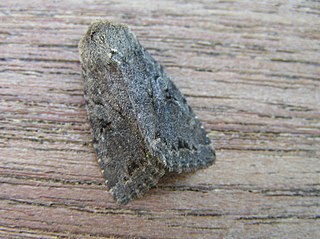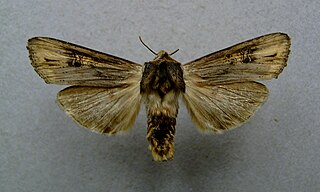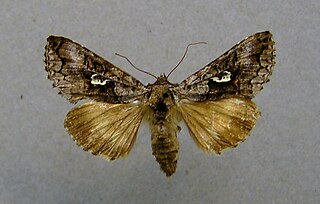Related Research Articles

Mythimna albipuncta, the white-point, is a moth of the family Noctuidae. The species was first described by Michael Denis and Ignaz Schiffermüller in 1775. It is distributed throughout Europe and one subspecies is found in Tunisia. It is also found in Asia Minor, Armenia, and Iran, and the northeastern United States.

Orthosia incerta, the clouded drab, is a species of moth of the family Noctuoidea. It is found in Europe. The occurrence of the species extends through all European countries through the Palearctic to the Russian Far East and Japan. It is absent from northern Fennoscandia. In the Alps it occurs up to 2000 m above sea level.

Lygephila pastinum, the blackneck, is a moth of the family Erebidae. The species was first described by Georg Friedrich Treitschke in 1826. It is found in Europe and across the Palearctic Siberia, the Russian Far East, Japan and China.

Hoplodrina blanda is a moth of the family Noctuidae. It is found in the Palearctic realm.

Fissipunctia ypsillon, the dingy shears, is a species of moth of the family Noctuidae. It is found in the Palearctic realm.

Xylena exsoleta, the sword-grass, is a species of moth of the family Noctuidae.

Euxoa obelisca, the square-spot dart, is a moth of the family Noctuidae. It is found in the Palearctic realm.

The Green-brindled Crescent(Allophyes oxyacanthae) is a moth of the family Noctuidae. It is found in Europe.

Catocala electa, the rosy underwing, is a moth of the family Erebidae. The species was first described by Karl Friedrich Vieweg in 1790. It can be found in Europe and Asia.

Syngrapha interrogationis, the scarce silver Y, is a moth of the family Noctuidae. It is found in the northern areas of the world, from Alaska, through Canada, Iceland, Europe, Siberia up to Northeast Asia including Japan.

Catocala nymphagoga, the oak yellow underwing, is a moth of the family Erebidae. It is found in Southern Europe, from Bulgaria up to the Iberian Peninsula and sometimes further north as a migrant. It is also found in North Africa and Asia Minor.

Apamea zeta is a moth of the family Noctuidae. It has a Holarctic distribution, and can be found throughout the Northern Hemisphere. It occurs throughout Europe and the northern half of North America.

Jodia croceago, the orange upperwing, is a moth of the family Noctuidae. The species was first described by Michael Denis and Ignaz Schiffermüller in 1775. It is found in southern and central Europe, to the north up to the southern half of England and Wales. According to Warren. W. in Seitz, A. Ed., 1914 also in Algeria, Asia Minor, and Armenia.

Lithophane furcifera, the conformist, is a moth of the family Noctuidae. The species was first described by Johann Siegfried Hufnagel in 1766. It is found from central Europe, east to the Black Sea region, the Caucasus and western Siberia. In the mountains, it is found up to elevations of 1,800 meters.

The butterbur is a species of moth in the family Noctuidae. It is found from most of Europe, east to Siberia and Japan.
Prionopaltis sericea is a moth in the family Crambidae. It was described by William Warren in 1892. It is found in Himachal Pradesh, India.
Syllepte seminigralis is a moth in the family Crambidae. It was described by William Warren in 1896. It is found in Meghalaya, India.
Udea nigripunctata is a moth in the family Crambidae. It was described by William Warren in 1892. It is found in Peru.
Callidrepana amaura is a moth in the family Drepanidae first described by Warren in 1901. It is found in Nigeria.
Oreta singapura is a moth in the family Drepanidae. It was described by Charles Swinhoe in 1892. It is found in Singapore, Malaysia, Indonesia and New Guinea.
References
- ↑ Nuss, M.; et al. (2003–2017). "GlobIZ search". Global Information System on Pyraloidea. Retrieved June 19, 2018.
- ↑ Warren, W. (1892). "Descriptions of new Genera and Species of Pyralidae contained in the British-Museum Collection". The Annals and Magazine of Natural History. 6. 9 (54): 438 – via Internet Archive.
| | This Spilomelinae-related article is a stub. You can help Wikipedia by expanding it. |